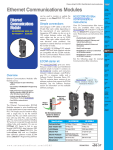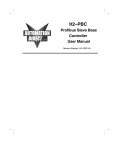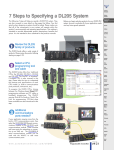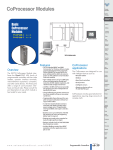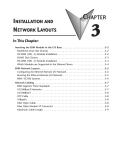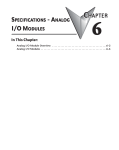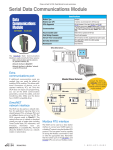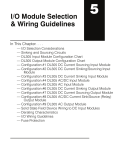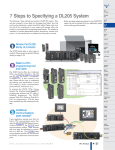Download Specifications
Transcript
HERE PLC Overview Step 6: Check the Power Budget 1.Using a chart similar to the one below, fill in column 2. Managing your power resource When determining the types and quantity of I/O modules you will be using, it is important to remember there is a defined amount of power available from the base power supply. The chart on the next page indicates the power supplied and used by each DL205 device. The adjacent chart shows an example of how to calculate the power used by your particular system. These charts should make it easy for you to determine if the devices you have chosen will operate within the power budget of your system configuration. If the I/O you have chosen exceeds the maximum power available from the power supply, you may be able to resolve the problem by using local expansion or remote I/O bases. 2.Using the tables on the next page, enter the current supplied and used by each device (columns 3 and 4). Devices which fall into the "Other" category (Row D) are devices such as the operator interface and the handheld programmer, which also have power requirements, but do not directly plug into the base. 3.Add the current used by the system devices (columns 3 and 4) starting with the CPU slot and put the total in the row labeled “Maximum Current Required” (Row E). DL05/06 PLC row labeled “Current Supplied” (Row B). Place the difference in the row labeled “Remaining Current Available” (Row F). 5.If “Maximum Current Required” is greater than “Current Supplied” in either column 3 or 4, the power budget will be exceeded. It will be unsafe to use this configuration, and you will need to restructure your I/O configuration. Note the auxiliary power supply does not need to supply all the external power. If you need more than the 300mA supplied, you can add an external 24V power supply. This will help keep you within your power budget for external power. 4.Subtract the row labeled “Maximum Current Required” (Row E), from the Column 1 A Column 2 Column 3 Device Type Base 5VDC (mA) Column 4 External Power 24 VDC (mA) 9 slot CPU SLOT SLOT 0 SLOT 1 SLOT 2 SLOT 3 SLOT 4 SLOT 5 SLOT 6 SLOT 7 Power budget example The example on the right shows how to calculate the power budget for the DL205 system. The examples are constructed around a single 9-slot base using the devices shown. It is recommended you construct a similar table for your DL205 system. Follow the steps to the right to determine your power budget. 2,600 300 D2-260 (CPU) D2-16ND3-2 D2-16ND3-2 D2-16NA D2-08NA-1 D2-16TD1-2 D2-08TA D2-08TA 330 100 100 100 50 200 250 250 0 0 0 0 0 80 0 0 Part Numbers Auxiliary 24 VDC Output Maximum Inrush Current Maximum Power Software C-more HMIs Other HMI Motors Steppers/ Servos Limit Switches Encoders Current Sensors DV-1000 D2-HPP 150 200 0 0 E Maximum Current Required 1730 80 F Remaining Current Available 2600-1520=1080 300-80=220 Pushbuttons/ Lights Process Relays/ Timers Comm. AC Powered Bases D2-03B-1, D2-04B-1, D2-06B-1, D2-09B-1 24 VDC Powered Bases D2-03BDC1-1, D2-04BDC1-1, D2-06BDC1-1, D2-09BDC1-1 125 VDC Powered Bases D2-03BDC-2, D2-04BDC-2, D2-06BDC2-1, D2-09BDC2-1 Voltage Withstand (dielectric) 1 minute @ 1,500 VAC between primary, secondary, field ground, and run relay > 10M at 500 VDC Insulation Resistance Input Voltage Range Field I/O Photo Sensors Power Supply Specifications Specification DL405 PLC Proximity Sensors D OTHER Operator interface Handheld programmer DL305 PLC Motor Controls C CURRENT REQUIRED The table below lists base power supply specifications, including maximum inrush current and maximum power consumed from your power source. DL205 PLC AC Drives B CURRENT SUPPLIED DL205 power supply specifications DL105 PLC 85-132 VAC (110 range) 170-264 VAC ( 220 range) 47-63Hz 10.2-28.8 VDC (24 VDC) with less than 10% ripple 300mA max. none 300mA max. 30A 10A 20A 80 VA 25W 30W w w w. a u to m at i o n d i re c t . c o m / d l 205 100-264 VDC (125 VDC) with less than 10% ripple PLC Products TB’s & Wiring Power Circuit Protection Enclosures Appendix Part Index 4–45 HERE Power Requirements These charts help determine your power requirements This section shows the amount of power supplied by each of the base power supplies and the amount of power consumed by each DL205 device. The Power Consumed charts list how much INTERNAL power from each power source is required for the DL205 devices. Use this information when calculating the power budget for your system. In addition to the internal power sources, the DL205 bases offer a 24 VDC auxiliary power supply with external power connections. This auxiliary power supply can power external devices. Use ZIPLinks to reduce 5VDC base power requirements If your application requires a lot of relay outputs, consider using the ZIPLink AC or DC relay output modules. These modules can switch high current (10A) loads without putting a load on your 5 VDC base power budget. Power Supplied Device Bases Price 5V(mA) 24V Auxiliary Device Bases Price 5V(mA) 24V Auxiliary D2-03B-1 <---> 2600 300 D2-06BDC1-1 <---> 2600 None D2-03BDC1-1 <---> 2600 None D2-06BDC2-1 <---> 2600 300 D2-04B-1 <---> 2600 300 D2-09B-1 <---> 2600 300 D2-04BDC1-1 <---> 2600 None D2-09BDC1-1 <---> 2600 None D2-06B-1 2600 300 D2-09BDC2-1 <---> 2600 300 <---> Power Consumed Power Consumed Device CPUs D2-230 D2-240 5V(mA) 120 120 24V Auxiliary 0 0 D2-250-1 330 0 D2-260 330 0 H2-WPLC*-** 680 0 DC Input Modules D2-08ND3 50 0 D2-16ND3-2 100 0 D2-32ND3 25 0 D2-32ND3-2 25 0 AC Input Modules Device 5V(mA) Analog Modules 24V Auxiliary F2-04AD-1 50 80 F2-04AD-1L 50 90 mA @ 12V F2-04AD-2 60 80 F2-04AD-2L 60 90 mA @ 12V F2-08AD-1 50 80 F2-08AD-2 50 80 F2-02DA-1 40 60 (note 1) F2-02DA-1L 40 70 @ 12V (note 1) F2-02DA-2 40 60 F2-02DA-2L 40 70 @ 12V F2-02DAS-1 F2-02DAS-2 100 100 50 / channel 60 / channel F2-08DA-1 30 50 (note 1) F2-08DA-2 60 140 D2-08NA-1 50 0 F2-4AD2DA 60 80 (note 1) For example, an 8-point F2-08TRS relay output module requires 670 mA @ 5 VDC. If you used a D2-16TD1-2 DC output module instead to drive a ZIPLink relay block, you would only use 200 mA @ 5 VDC, and you’d have eight more relay outputs at a higher rated load current switching capacity. Refer to the Terminal Blocks and Wiring section to find out more about ZIPLink cables and connector modules. D2-08NA-2 100 0 F2-8AD4DA-1 35 100 (note 1) D2-16NA 100 0 F2-8AD4DA-2 35 80 (note 1) F2-04RTD 90 0 F2-04THM 110 60 This logo is placed by the I/O modules that are supported by the ZIPLink connection systems. See the I/O module specifications at the end of this section. Input Simulator Module F2-08SIM 50 0 DC Output Modules Specialty Modules D2-04TD1 60 20 D2-CTRINT 50* 0 D2-08TD1 100 0 D2-CM / D2-EM 100/130 0 D2-08TD2 100 0 H2-CTRIO 400 0 D2-16TD1-2 200 80 D2-DCM 300 0 D2-16TD2-2 200 0 F2-DEVNETS 160 0 D2-32TD1 350 0 F2-SDS-1 160 0 D2-32TD2 350 0 H2-PBC 530 0 H2-EBC(-F) 450, (640) 0 AC Output Modules D2-08TA 250 0 H2-ECOM(-F) 450, (640) 0 F2-08TA 250 0 H2-ECOM100 300 0 D2-12TA 350 0 F2-CP128 235 0 Relay Output Modules Power Consumed Device 5V(mA) 24V Auxiliary Operator Interface DV-1000 150 C-more MicroGraphic 4–46 0 Remote I/O D2-04TRS 250 0 H2-ERM(-F) 320, (450) 0 D2-08TR 250 0 D2-RMSM 200 0 F2-08TR(S) 670 0 D2-RSSS 150 0 D2-12TR 450 0 Programming Devices Combination In/Out Module 210 PLC Products 0 D2-08CDR 200 D2-HPP 0 200 0 *requires external 5VDC for outputs Note 1: Add an additional 20 mA per output loop. 1 - 80 0 - 633 - 0405 HERE PLC Overview Dimensions and Installation DL05/06 PLC DL105 PLC Understanding the installation requirements for your DL205 system will help ensure that the DL205 products operate within their environmental and electrical limits. See the Enclosures section for an enclosure that may be suitable for your application Plan for safety Software C-more HMIs 2" 50mm min Base dimensions and mounting Use the diagrams below to make sure the DL205 system can be installed in your application. To ensure proper airflow for cooling purposes, DL205 bases must be mounted horizontally. It is important to check these dimensions against the conditions required for your application. For example, it is recommended that approximately 3" of space is left in front PLC surface for ease of access and cable clearances. Also, check the installation guidelines for recommended cabinet clearances. 5.85” 148mm 4.45” 113mm 3.62” 92mm 2.95” 75mm AC Drives Motors Steppers/ Servos Motor Controls Environmental Specification Storage Temperature Ambient Operating Temperature Ambient Humidity Vibration Resistance Shock Resistance Noise Immunity Atmosphere Rating Proximity Sensors -4 F - 158 F (-20 C to 70 C) o o o o 32oF - 131oF (0oC to 55oC) Photo Sensors 30%-95% relative humidity (non-condensing) Limit Switches MIL STD 810C, Method 514.2 MIL STD 810C, Method 516.2 Encoders NEMA (ICS3-304) No corrosive gases Base A B Current Sensors C D D2-03B-1, D2-03BDC1-1, D2-03BDC-2 6.77" 172mm 6.41" 163mm 5.8" D2-04B-1, D2-04BDC1-1 7.99" 203mm 7.63" 194mm 7.04" 179mm 8.46" 215mm D2-06B-1, D2-06BDC1-1, D2-06BDC2-1 10.43" 265mm 10.07" 256mm 9.48" 241mm 10.90" 277mm D2-09B-1, D2-09BDC1-1, D2-09BDC2-1 14.09" 358mm 13.74" 349mm 13.14" 334mm 14.56" 370mm A C With 8pt. I/O Other HMI 2" 50mm min The Environmental Specifications table at the right lists specifications that apply globally to the DL205 system (CPUs, bases, and I/O modules). Be sure that the DL205 system is operated within these environmental specifications. With 16pt. I/O Field I/O 2" 50mm min Environmental specifications With 32pt. ZipLink cable or base expansion unit cable DL305 PLC DL405 PLC This catalog should never be used as a replacement for the user manual. The user manual, D2-USER-M (sold separately or downloadable online), contains important safety information that must be followed. The system installation should comply with all appropriate electrical codes and standards. With D2-DSCB-1 on port 2 DL205 PLC 148mm 7.24" 184mm Pushbuttons/ Lights Process Relays/ Timers Comm. OK TB’s & Wiring 3.54” 90mm 2.99” 76mm B Power Circuit Protection Airflow Enclosures With D2-EM base expansion module D Appendix DIN rail slot (35mm) w w w. a u to m at i o n d i re c t . c o m / d l 205 Part Index PLC Products 4–47




